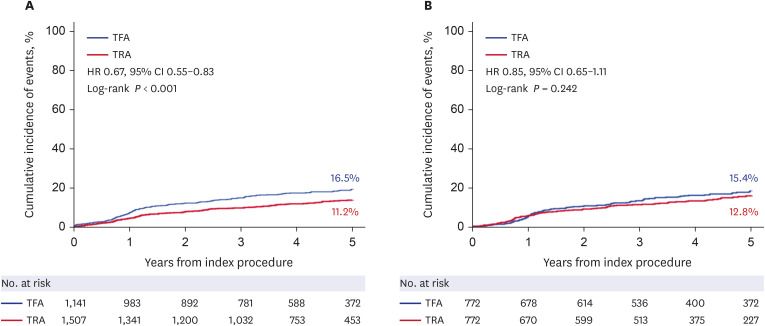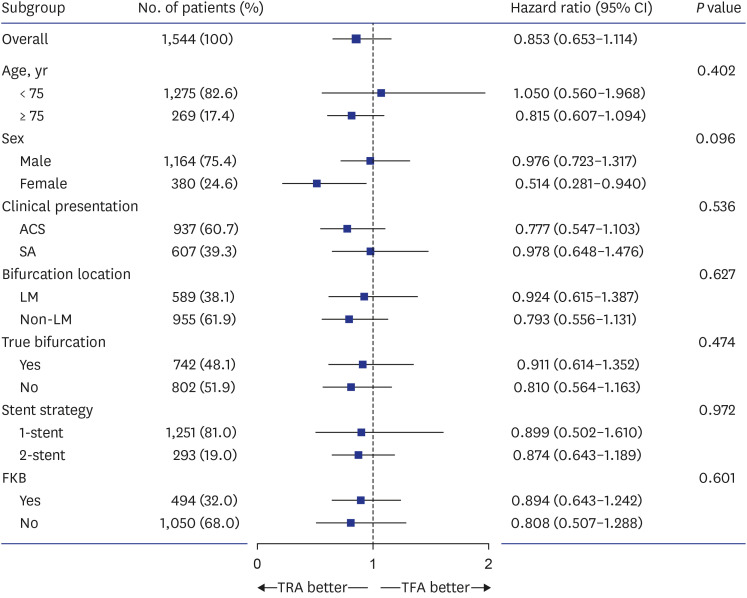J Korean Med Sci.
2024 Mar;39(10):e111. 10.3346/jkms.2024.39.e111.
Transradial Versus Transfemoral Access for Bifurcation Percutaneous Coronary Intervention Using SecondGeneration Drug-Eluting Stent
- Affiliations
-
- 1Division of Cardiology, Department of Internal Medicine, Wonju Severance Christian Hospital, Yonsei University Wonju College of Medicine, Wonju, Korea
- 2Division of Cardiology, Department of Internal Medicine, Heart Vascular Stroke Institute, Samsung Medical Center, Sungkyunkwan University School of Medicine, Seoul, Korea
- 3Department of Internal Medicine and Cardiovascular Centre, Seoul National University Hospital, Seoul National University College of Medicine, Seoul, Korea
- 4Division of Cardiology, Department of Internal Medicine, Samsung Changwon Hospital, Sungkyunkwan University School of Medicine, Changwon, Korea
- 5Division of Cardiology, Department of Internal Medicine, Keimyung University Dongsan Medical Centre, Keimyung University College of Medicine, Daegu, Korea
- 6Division of Cardiology, Department of Internal Medicine, Gachon University Gil Hospital, Gachon University College of Medicine, Incheon, Korea
- 7Division of Cardiology, Department of Internal Medicine, Korea University Guro Hospital, Korea University College of Medicine, Seoul, Korea
- 8Division of Cardiology, Department of Internal Medicine, Seoul National University Bundang Hospital, Seoul National University College of Medicine, Seongnam, Korea
- 9Division of Cardiology, Department of Internal Medicine, Chungnam National University Hospital, Chungnam National University College of Medicine, Daejeon, Korea
- 10Division of Cardiology, Department of Internal Medicine, Kosin University Gospel Hospital, Kosin University College of Medicine, Busan, Korea
- 11Division of Cardiology, Department of Internal Medicine, Korea University Anam Hospital, Korea University College of Medicine, Seoul, Korea
- 12Division of Cardiology, Department of Internal Medicine, Yeungnam University Medical Center, Yeungnam University College of Medicine, Daegu, Korea
- 13Division of Cardiology, Department of Internal Medicine, Severance Cardiovascular Hospital, Yonsei University College of Medicine, Seoul, Korea
- 14Division of Cardiology, Department of Internal Medicine, Inje University Ilsan Paik Hospital, Inje University College of Medicine, Goyang, Korea
- 15Division of Cardiology, Department of Internal Medicine, Pusan National University Hospital, Pusan National University College of Medicine, Busan, Korea
- 16Division of Cardiology, Department of Internal Medicine, Inje University Haeundae Paik Hospital, Inje University College of Medicine, Busan, Korea
- 17Division of Cardiology, Department of Internal Medicine, Chung-Ang University Gwangmyeong Hospital, Chung-Ang University College of Medicine, Gwangmyeong, Korea
- 18Division of Cardiology, Department of Internal Medicine, Seoul St. Mary’s Hospital, The Catholic University of Korea College of Medicine, Seoul, Korea
- 19Division of Cardiology, Department of Internal Medicine, St. Paul’s Hospital, The Catholic University of Korea College of Medicine, Seoul, Korea
- 20Division of Cardiology, Department of Internal Medicine, Ajou University Hospital, Ajou University College of Medicine, Suwon, Korea
- 21Division of Cardiology, Department of Internal Medicine, Chonnam National University Hospital, Chonnam National University College of Medicine, Gwangju, Korea
- 22Division of Cardiology, Department of Internal Medicine, Bucheon Sejong Hospital, Bucheon, Korea
- KMID: 2554195
- DOI: http://doi.org/10.3346/jkms.2024.39.e111
Abstract
- Background
The benefits of transradial access (TRA) over transfemoral access (TFA) for bifurcation percutaneous coronary intervention (PCI) are uncertain because of the limited availability of device selection. This study aimed to compare the procedural differences and the in-hospital and long-term outcomes of TRA and TFA for bifurcation PCI using secondgeneration drug-eluting stents (DESs).
Methods
Based on data from the Coronary Bifurcation Stenting Registry III, a retrospective registry of 2,648 patients undergoing bifurcation PCI with second-generation DES from 21 centers in South Korea, patients were categorized into the TRA group (n = 1,507) or the TFA group (n = 1,141). After propensity score matching (PSM), procedural differences, in-hospital outcomes, and device-oriented composite outcomes (DOCOs; a composite of cardiac death, target vessel-related myocardial infarction, and target lesion revascularization) were compared between the two groups (772 matched patients each group).
Results
Despite well-balanced baseline clinical and lesion characteristics after PSM, the use of the two-stent strategy (14.2% vs. 23.7%, P = 0.001) and the incidence of in-hospital adverse outcomes, primarily driven by access site complications (2.2% vs. 4.4%, P = 0.015), were significantly lower in the TRA group than in the TFA group. At the 5-year follow-up, the incidence of DOCOs was similar between the groups (6.3% vs. 7.1%, P = 0.639).
Conclusion
The findings suggested that TRA may be safer than TFA for bifurcation PCI using second-generation DESs. Despite differences in treatment strategy, TRA was associated with similar long-term clinical outcomes as those of TFA. Therefore, TRA might be the preferred access for bifurcation PCI using second-generation DES.
Figure
Reference
-
1. Jolly SS, Yusuf S, Cairns J, Niemelä K, Xavier D, Widimsky P, et al. Radial versus femoral access for coronary angiography and intervention in patients with acute coronary syndromes (RIVAL): a randomised, parallel group, multicentre trial. Lancet. 2011; 377(9775):1409–1420. PMID: 21470671.
Article2. Romagnoli E, Biondi-Zoccai G, Sciahbasi A, Politi L, Rigattieri S, Pendenza G, et al. Radial versus femoral randomized investigation in ST-segment elevation acute coronary syndrome: the RIFLE-STEACS (Radial Versus Femoral Randomized Investigation in ST-Elevation Acute Coronary Syndrome) study. J Am Coll Cardiol. 2012; 60(24):2481–2489. PMID: 22858390.
Article3. Valgimigli M, Frigoli E, Leonardi S, Vranckx P, Rothenbühler M, Tebaldi M, et al. Radial versus femoral access and bivalirudin versus unfractionated heparin in invasively managed patients with acute coronary syndrome (MATRIX): final 1-year results of a multicentre, randomised controlled trial. Lancet. 2018; 392(10150):835–848. PMID: 30153988.4. Neumann FJ, Sousa-Uva M, Ahlsson A, Alfonso F, Banning AP, Benedetto U, et al. 2018 ESC/EACTS guidelines on myocardial revascularization. Eur Heart J. 2019; 40(2):87–165. PMID: 30165437.
Article5. Writing Committee Members. 2021 ACC/AHA/SCAI guideline for coronary artery revascularization: a report of the American College of Cardiology/American Heart Association Joint Committee on Clinical Practice Guidelines. J Am Coll Cardiol. 2022; 79(2):e21–129. PMID: 34895950.6. Steigen TK, Maeng M, Wiseth R, Erglis A, Kumsars I, Narbute I, et al. Randomized study on simple versus complex stenting of coronary artery bifurcation lesions: the Nordic bifurcation study. Circulation. 2006; 114(18):1955–1961. PMID: 17060387.
Article7. Latib A, Colombo A. Bifurcation disease: what do we know, what should we do? JACC Cardiovasc Interv. 2008; 1(3):218–226. PMID: 19463303.8. Chung S, Her SH, Song PS, Song YB, Hahn JY, Choi JH, et al. Trans-radial versus trans-femoral intervention for the treatment of coronary bifurcations: results from Coronary Bifurcation Stenting Registry. J Korean Med Sci. 2013; 28(3):388–395. PMID: 23486858.
Article9. Chung S, Yang JH, Choi SH, Song YB, Hahn JY, Choi JH, et al. Transradial versus transfemoral intervention for the treatment of left main coronary bifurcations: results from the COBIS (COronary BIfurcation Stenting) II Registry. J Invasive Cardiol. 2015; 27(1):35–40. PMID: 25589699.10. Choi KH, Song YB, Lee JM, Park TK, Yang JH, Hahn JY, et al. Prognostic effects of treatment strategies for left main versus non-left main bifurcation percutaneous coronary intervention with current-generation drug-eluting stent. Circ Cardiovasc Interv. 2020; 13(2):e008543. PMID: 32069106.
Article11. Louvard Y, Thomas M, Dzavik V, Hildick-Smith D, Galassi AR, Pan M, et al. Classification of coronary artery bifurcation lesions and treatments: time for a consensus! Catheter Cardiovasc Interv. 2008; 71(2):175–183. PMID: 17985377.
Article12. Ferrante G, Rao SV, Jüni P, Da Costa BR, Reimers B, Condorelli G, et al. Radial versus femoral access for coronary interventions across the entire spectrum of patients with coronary artery disease: a meta-analysis of randomized trials. JACC Cardiovasc Interv. 2016; 9(14):1419–1434. PMID: 27372195.
Article13. Ahn SG, Lee JW, Youn YJ, Lee SH, Cho JH, Kang WC, et al. In-hospital outcome differences between transradial and transfemoral coronary approaches: data from the Korean Percutaneous Coronary Intervention registry. Catheter Cardiovasc Interv. 2019; 94(3):378–384. PMID: 30604498.
Article14. Goel S, Pasam RT, Raheja H, Gotesman J, Gidwani U, Ahuja KR, et al. Left main percutaneous coronary intervention-radial versus femoral access: a systematic analysis. Catheter Cardiovasc Interv. 2020; 95(7):E201–E213. PMID: 31430040.
Article15. Yoo BS, Yoon J, Ko JY, Kim JY, Lee SH, Hwang SO, et al. Anatomical consideration of the radial artery for transradial coronary procedures: arterial diameter, branching anomaly and vessel tortuosity. Int J Cardiol. 2005; 101(3):421–427. PMID: 15907410.
Article16. Meijers TA, Aminian A, van Wely M, Teeuwen K, Schmitz T, Dirksen MT, et al. Randomized comparison between radial and femoral large-bore access for complex percutaneous coronary intervention. JACC Cardiovasc Interv. 2021; 14(12):1293–1303. PMID: 34020929.
Article17. Youn YJ, Yoon J, Han SW, Lee JW, Sung JK, Ahn SG, et al. Feasibility of transradial coronary intervention using a sheathless guiding catheter in patients with small radial artery. Korean Circ J. 2011; 41(3):143–148. PMID: 21519513.
Article18. Albiero R, Burzotta F, Lassen JF, Lefèvre T, Banning AP, Chatzizisis YS, et al. Treatment of coronary bifurcation lesions, part I: implanting the first stent in the provisional pathway. The 16th expert consensus document of the European Bifurcation Club. EuroIntervention. 2022; 18(5):e362–e376. PMID: 35570748.
Article
- Full Text Links
- Actions
-
Cited
- CITED
-
- Close
- Share
- Similar articles
-
- Novel Coronary Stent Platforms
- Drug-Eluting Stent: Present and Future
- Percutaneous Treatment of an Injured Coronary Stent Using the Looping Wire Technique
- Recent Advances in Percutaneous Coronary Intervention in Coronary Artery Disease
- Successful Treatment of a Coronary Artery Aneurysm that Developed with In-Stent Restenosis after Drug-Eluting Stent Implantation



